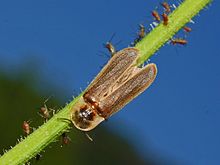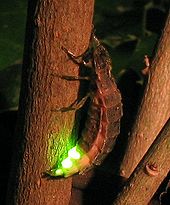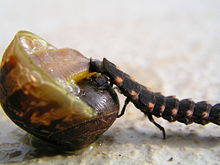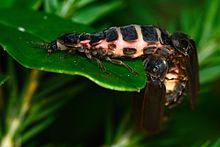Lampyris noctiluca
| Lampyris noctiluca | |
|---|---|

| |
| Male | |

| |
| Left: Adult female Right: same as left, emitting light | |
| Scientific classification | |
| Domain: | Eukaryota |
| Kingdom: | Animalia |
| Phylum: | Arthropoda |
| Class: | Insecta |
| Order: | Coleoptera |
| Family: | Lampyridae |
| Subfamily: | Lampyrinae |
| Tribe: | Lampyrini |
| Genus: | Lampyris |
| Species: | L. noctiluca
|
| Binomial name | |
| Lampyris noctiluca | |
| Synonyms | |
|
Cantharis noctiluca Linnaeus, 1767 | |
Lampyris noctiluca,[1] the common glow-worm of Europe (see also "glowworm"), is the type species of beetle in the genus Lampyris and the family Lampyridae.
Lampyris noctiluca presents a conspicuous sexual dimorphism. The males are winged, with brown elytra, a clearer pronotum and a large brown spot in the middle, while females are larviforme, wings are missing and they are often twice the size of the males (up to 25 millimetres or 1 inch in length).
These beetles use their bioluminescence to attract mates. The adult females are mostly famed for their glow, although all stages of their life cycle are capable of glowing.
In Britain, this species is fairly common compared to its cousin Phosphaenus hemipterus – the lesser glow worm – which is very rare.[citation needed]
The Lampyris noctiluca, commonly referred to as a glow worm, belongs to the Lampyridae family, which is Greek for "shining ones," and includes species known as fireflies or lightning bugs. Contrary to its name, it is not worm-like, but a beetle. These beetles are typically the most active at night and spend their day under debris, or in the ground. The larvae are also nocturnal and rarely seen — only coming out when the conditions are right in the months of April through October. The adult stage is much shorter than the larvae stage but they are much easier to spot then as they glow for a few hours and only stop glowing after mating.
Distribution[edit]
The range of this beetle stretches from Portugal and Ireland [citation needed] in the west, right across Europe, Africa and Asia to China in the east. It also survives further north than any other firefly, almost reaching the Arctic Circle. It is not found in North America, South America, South Asia, Australia and Antarctica.
Geography[edit]
The Lampris noctiluca has been found mainly in valleys in Wales and Scotland with other appearance in Europe, such as Belgium and Finland. They typically favor chalky and limestone areas, open grass, hedges, and woodland and will rarely be found on land which has been improved for agricultural purposes. They prefer open air, especially for evolutionary purposes for the female to be able to attract a male through her light display during the months of June, July, and August.
Physical description[edit]
The Lampyris noctiluca adult females range in size from 12-20 mm while males are significantly smaller. Larvae are only a few millimeters in length (1). They also have segmented bodies such that females may emit a bioluminescent glow (2). The species exhibits a coloration from brownish to blackish. Males are equipped with two pairs of wings, using the second pair for flying and the first pair, known as elytra, to cover the second. Females, however, do not fly. The insects are characterized by their soft-bodied and elongated form, with a head concealed by a pronotum and threadlike antennae. Luminosity is confined to the last few abdominal segments. Among them, the adult female is notably the most luminous, using her glowing ability to attract males, while larvae also glow but more faintly and only intermittently. The light produces is cold light which benefits the species as they waste little heat. The transform only about 3 percent of their electrical energy into light which is relatively efficient compared to other glowing species. Despite the larvae's similarity to adults in having segmented bodies and six legs near the head, their mode of movement can make them resemble caterpillars.(1).
Chemistry of Light[edit]
For Lampyris noctiluca, or glow worms, producing light is crucial to their mating success, involving an intricate process. These creatures emit a yellowish-green luminescence from the translucent skin on the underside of their last three abdominal segments to lure in the smaller, winged males. They shine for about two hours each night, either retreating to safety after this period or ceasing their glow upon finding a mate, managing to do so for up to 10 consecutive nights. Males can spot this light from as far as 45 meters away. The light is steady, but the females enhance its allure by rhythmically moving their abdomens, creating a pulsing effect of brightening and dimming. While larvae also have the ability to glow, they can more readily switch off their light, particularly if they sense danger. The glow is also observed in pupae when they are disturbed.
Glow worms control their luminescence by regulating the oxygen flow to the light-producing membranes that contain luciferin. This light results from a chemical reaction facilitated by the enzyme luciferase, with its specific structure influenced by the worm's genetic makeup, leading to minor variations in the light among individuals (3). Specifically, the chemistry behind the beetle’s luminescence is the outcome of a chemical reaction involving three essential components: a small organic molecule known as luciferin, named after the bringer of light, the fallen archangel Lucifer; adenosine triphosphate (ATP), a crucial molecule that fuels the synthesis of proteins; and luciferase, the catalyst that drives this illuminating process.(1). Remarkably, this bioluminescent process is highly efficient, converting nearly all its energy output into light with only about 2% lost as heat. The intensity of a female's glow serves as a signal to males, indicating her reproductive potential. Males are drawn to brighter females, which typically indicate a larger size and a higher egg count, prompting a competitive dynamic among females for mating opportunities. Interestingly, artificial lights can also attract males, diverting them from their natural mating pursuits. The peak activity for their glowing display occurs during the evenings of June and July, marking the most vibrant time in their reproductive calendar (3).
Light production[edit]

Light production is vital for Lampyris noctiluca. With it they have greater chances of mating, so there is a complex process involved.
They emit yellowish-green light from the translucent underside of their last three abdominal segments to attract the smaller males, which are winged. They will glow for two hours and then retreat back into their hiding place until the next night, or stop glowing as soon as they find a mate. The females can survive for at least 10 consecutive nights doing this.
The light can be seen by males up to 45 metres away. The light is emitted continuously, although they will wave their abdomens from side to side, which gives the impression of it brightening and dimming. Larvae are sometimes seen to glow, although they seem able to turn off their light more easily than the female, especially when disturbed. The pupae glow when disturbed.[2]
The insect can regulate its light production by controlling the oxygen supply to the light emitting membranes containing luciferin. The chemical reaction producing the light from luciferin is catalysed by luciferase, the exact chemical structure of which is determined by the glow worms' individual genetic structure, which in turn determines subtle differences in the light produced from individual to individual. Virtually all of the energy produced is light; only 2% is heat.
The brightness of the glow is used by the males as an indicator of female fecundity.[3] Males are more likely to fly to a brighter female, because it is larger and has more eggs. Due to this, females compete against each other for matings.[4]
The males are sometimes attracted to man-made light fixtures.
The peak glowing period is evenings in June and July.[5]
Reproduction[edit]
In the reproduction process of the Lampyris noctiluca, or glow worm, the female plays a crucial role in attracting mates. To catch the attention of male glow worms, which fly about a meter off the ground, a female climbs a plant stalk. By positioning herself above most ground-level vegetation and bending her abdomen upwards, she showcases her glowing organs, signaling to any males passing by. This display is part of her adult life, which spans only a few weeks dedicated to glowing, mating, and laying eggs before her death. The eggs hatch into larvae after a few weeks, undergoing a larval stage that lasts for one or two summers, during which they feed on small snails by paralyzing them before consumption. This lengthy development cycle contributes to the observed "boom or bust" population cycles of the species, with abundance fluctuating significantly from one year to the next.
Unique to Lampyris noctiluca is its method of sex determination, which is influenced by hormones, a rarity among insects. Sexual differentiation between males and females begins during the fourth larval instar, with distinctions being initially subtle. Male cells in the apical tissue of the gonads start to divide at this stage, contrasting with female cells, which divide in the basal tissue. Remarkably, transplanting testes into females before the fifth instar leads to masculinization, whereas similar procedures performed later or attempts to feminize males do not result in sex reversal. This demonstrates that while testes can transform pre-fifth instar female gonads into male ones, ovaries do not have a feminizing effect on males, highlighting a unique aspect of the species' biology.(2).
Life Cycle[edit]
The life cycle begins when the female, using her luminous glow, attracts a male to mate. After mating, she lays between 50 to 100 eggs over a span of three days in moist environments such as under moss, leaf litter, or on grass stems, and then dies without witnessing the hatching of her eggs. These pale yellow eggs, each about 1 mm in diameter, may emit a faint yellow glow and hatch within two to three weeks, with the duration potentially extending in colder climates. Upon hatching, the larvae, resembling adult females but distinguished by bright spots on each of their 12 segments, embark on a two to three-year predatory phase. They primarily feed on slugs and snails, which can be up to 200 times their own weight, by injecting them with a toxic, brown digestive fluid through multiple nips and bites. This method allows the larva to consume the prey without getting stuck to any protective mucus, turning the prey into a digestible broth.
Remarkably, these larvae are nocturnal and most active during moist conditions which favor the activity of their prey. Throughout their larval stage, they may undergo four to five moults and hibernate under logs, stones, or leaf litter during winter when food becomes scarce. Upon awakening in spring, they continue their lifecycle, which can extend over one or more years. The transition to adulthood occurs from May to July or sometimes later, with the adults living off the food reserves accumulated during their larval stage. After reaching maturity, their life culminates in reproduction, following which they die, completing the cycle.(3). The adults typically don’t live for more than two or three weeks (6).
Food[edit]
They undergo their entire feeding phase during the larval stage, The larvae are fierce predators and roam leaf litter in search of slugs and snails. (1). They do this by injecting their prey with digestive enzymes and then consuming the liquefied internal contents. In stark contrast, the adult glow worms lack mouthparts entirely, rendering them unable to eat.(2).
Light Pollution Problems[edit]
These beetles rely heavily on light for their reproductive processes. However, the rise of artificial lighting, even in rural settings, poses a significant challenge. Such light sources can complicate the males' search for partners. A 2014 study highlighted that minimal levels of light pollution can disrupt the mating behaviors of male L. noctiluca, as they struggle to find females. This research underscores the potential link between declining glow-worm populations and light pollution, suggesting that it warrants consideration as a contributing factor.(5).
Habitat[edit]
They are found in old-growth grassland, especially on chalk and limestone soils. They are also found in verges, hedgebanks, and on heaths. The larvae live in sheltered places – under rocks and wood, but do crawl over different terrains.
Lifecycle[edit]



Once the females have attracted the males with their glow, they mate, lay eggs, and die.
Typically, 50–100 are laid over three days, with the adult not surviving to see them hatch. They are laid in fairly moist places, e.g. stems of grass, under moss and under leaf litter.[6]
The eggs are pale yellow, 1 mm across. They may glow faintly yellow.[6]
The eggs hatch after two or three weeks, possibly longer in colder climates.[6] Larvae and adult females look similar, but larvae have bright spots on each of 12 segments, whereas adult females have a completely black back.
The predatory larvae feed for two or three years on slugs and snails which they inject with a brown, toxic, digestive fluid, delivered by a series of nips and bites. The poison takes time to work, and the larva must to be careful not to become stuck to any protective mucus that its prey may secrete. The prey is gradually paralysed and the digestive fluid turns part of it into a brown broth that the larva can lap up. The prey remains alive, and some partially eaten victims have been known to crawl away after the meal.
The slugs and snails are often 200 times the weight of the beetle larva. The larvae are nocturnal, and are most active during moist conditions, when their prey are most active.
The larvae may moult four to five times in their lifetimes.[2][6] They spend winters under logs, stones, wood holes, or leaf litter, their bodies drawn in like concertinas, hibernating as food becomes increasingly difficult to find. They awaken in spring, and the cycle is repeated for one more year, or possibly two.[6]
They become adults from May to July or sometimes later, surviving on food reserves accumulated during time as a larva, and dying after reproducing.
Threats to species numbers[edit]
Threats include habitat destruction, habitat fragmentation, pesticide use, pollution, distraction by artificial lights, insufficient grazing and climate change.[7][8]
References[edit]
- ^ Linnaeus C (1758) Systema Naturae per regna tria naturæ, secundum classes, ordines, genera, species, cum characteribus, differentiis, synonymis, locis, Tomus I. Editio decima, reformata. Holmiæ: impensis direct. Laurentii Salvii. i–ii, 1–824 pp doi:10.5962/bhl.title.542: 400
- ^ a b Novák, Martin (2017-03-28). "Redescription of immature stages of central European fireflies, Part 1: Lampyris noctiluca (Linnaeus, 1758) larva, pupa and notes on its biology (Coleoptera: Lampyridae: Lampyrinae)". Zootaxa. 4247 (4): 429–444. doi:10.11646/zootaxa.4247.4.5. ISSN 1175-5334. PMID 28610049.
- ^ Hopkins, Juhani; Baudry, Gautier; Candolin, Ulrika; Kaitala, Arja (2015). "I'm sexy and I glow it: female ornamentation in a nocturnal capital breeder". Biology Letters. 11 (10): 20150599. doi:10.1098/rsbl.2015.0599. PMC 4650175. PMID 26490414.
- ^ Borshagovski, Anna-Maria; Baudry, Gautier; Hopkins, Juhani; Kaitala, Arja (January–February 2019). "Pale by comparison: competitive interactions between signaling female glow-worms". Behavioral Ecology. 161: 20–26. doi:10.1093/beheco/ary161.
- ^ Hickmott, W; Tyler J. (2011). "Seasonal variation in the female display period of the glow-worm Lampyris noctiluca L. (Coleoptera: Lampyridae)". Lampyrid. 1: 14–21.
- ^ a b c d e "Lampyris noctiluca". uk beetles. Retrieved 2022-10-14.
- ^ Lewis, Sara M.; Wong, Choong Hay; Owens, Avalon C. S.; Fallon, Candace; Jepsen, Sarina; Thancharoen, Anchana; Wu, Chiahsiung; De Cock, Raphael; Novák, Martin; López-Palafox, Tania; Khoo, Veronica; Reed, J. Michael (1 February 2020). "A Global Perspective on Firefly Extinction Threats". BioScience. 70 (2): 157–167. doi:10.1093/biosci/biz157. ISSN 0006-3568. Retrieved 27 August 2020.
- ^ Owens, Avalon C. S.; Lewis, Sara M. (2018). "The impact of artificial light at night on nocturnal insects: A review and synthesis". Ecology and Evolution. 8 (22): 11337–11358. doi:10.1002/ece3.4557. PMC 6262936. PMID 30519447. S2CID 54459377.
External links[edit]
- Identification of European Glowworms
- Kendall Bioresearch
- The UK Glow Worm survey home page contains a wealth of information on this species
- UK Distribution
- Biolib
